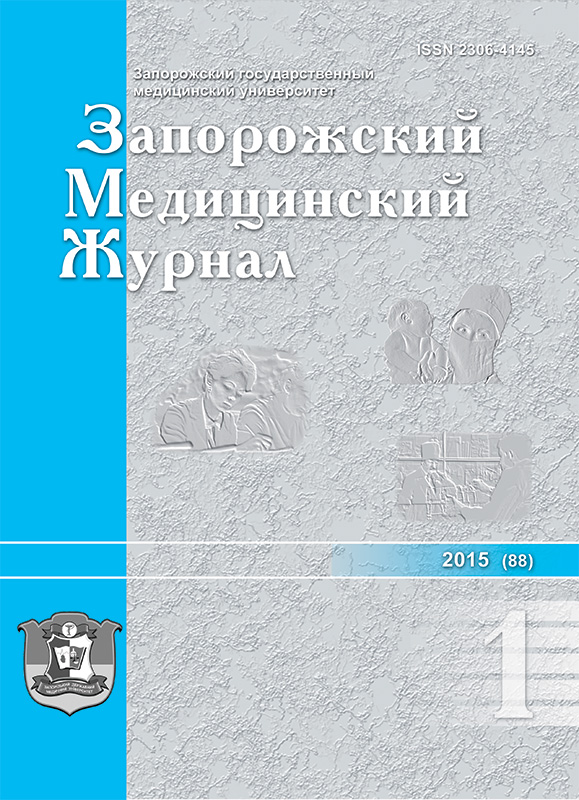Сatamnestic analysis of the effectiveness of complex rehabilitation of patients with vertebrogenic dorsalgia, radiculopathy
DOI:
https://doi.org/10.14739/2310-1210.2015.1.39214Keywords:
dorsalgia, catamnestic analysis, rehabilitationAbstract
Aim. Existing methods of rehabilitation of patients with vertebrogenic dorsalgia characterized by short-term effect of healing and do not exclude frequent relapses and complications of treatment. Effectiveness of different methods of rehabilitation were compared.
Methods and results. 63 patients were examined using scoliosometry, determination of the static and dynamic endurance of the abdominal muscles, muscle dynamometry of the extensor muscles of the back, and indexes of algotonus and vertebral syndrome. It was revealed that the lower index values of the algotonus and vertebral syndrome, lumbar scoliosis were more in patient that andergone proposed scheme of the rehabilitation. Postural dynamometry and static muscle endurance- extensor back, static and dynamic endurance of the abdominal muscles differed too in that group.
Conclusion. This testifies the higher efficacy of the author's method of rehabilitation of dorsalgia.
References
Bobryk, Yu. V., & Kaladze, N. N. (2012). Suchasni tekhnolohii kompleksnoi reabilitatsii khvorykh iz nevrolohichnymy proiavamy osteokhondrozu poperekovo-kryzhovoho viddilu khrebta [Modern technology of complex rehabilitation of patients with neurological manifestations of osteochondrosis of the lumbosacral spine: guidelines]. Kyiv. [in Ukrainian].
Lyseniuk, V. P., Samosiuk, I. Z., Fisenko, L. I., et al. (2007) Medychna reabilitatsiia: suchasni standarty, testy, shkaly ta kryterii efektyvnosti. Nyzkointensyvna rezonansna fizioterapiia i ii zastosuvannia v reabilitatsiinii medytsyni [Medical rehabilitation of: modern standards, tests, scales and criteria of effectiveness. Low intensity resonance physiotherapy use in rehabilitation medicine]. Kyiv. [in Ukrainian].
Bobryk, Yu. V. (patentee) (2010) Patent na korysnu model №46968 Ukraina. MPK A 61 V 5/00. Cposib diahnostyky velychyny skoliotychnoi deformatsii khrebta [Patent for Utility Model number 46968 Ukraine. IPC A 61 B 5/00. Method diagnostic value of scoliotic spinal deformity]. Biuleten, 1. [in Ukrainian].
Popelyanskij, Ya. Yu. (2008) Ortopedicheskaya nevrologiya (vertebronevrologiya): rukovodstvo dlya vrachej [Orthopaedic Neurology (vertebroneurology): a guide for physicians]. Moscow: MEDpress-inform. [in Russian].
Prodan, A. I., Radchenko, V. A., & Korzh, I. A. (2009) Degenerativnye zabolevaniya pozvonochnika [Degenerative diseases of the spine]. Kharkov: Contrast. [in Ukrainian].
Romanenko, V. A. (2005) Diagnostika dvigatel'nykh sposobnostej [Diagnosis of motor abilities]. Donetsk. [in Ukrainian].
Kiese, K. B., Underwood, F. B., Mattacola, C. G., Nitz, A. J., & Malone, T. R. (2007) A comparison of select trunk muscle thickness change between subjects with low back pain classified in the treatment-based classification system and asymptomatic controls. Phys Ther, 10, 596–607.
Mannion, A. F., Pulkovski, N., Gubler, D., Gorelick, M., O'Riordan, D., Loupas, T., et al. (2008) Muscle thickness changes during abdominal hollowing: an assessment of between- day measurement error in controls and patients with chronic low back pain. Eur Spine J., 4, 494–501 doi: 10.1007/s00586-008-0589-x.
Downloads
How to Cite
Issue
Section
License
Authors who publish with this journal agree to the following terms:
Authors retain copyright and grant the journal right of first publication with the work simultaneously licensed under a Creative Commons Attribution License that allows others to share the work with an acknowledgement of the work's authorship and initial publication in this journal. 

